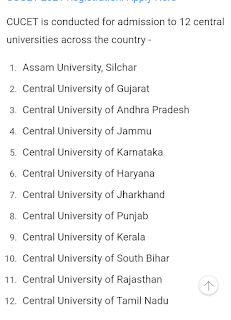M.Sc. Botany PG entrance - syllabus , Test papers ,examination Date
CPGET-2021 Syllabus
BOTANY
Part-A (40 Marks):
Microbial Diversity of Lower Plants:
Brief account of Archaebacteria, Actinomycetes. Viruses: Structure, replication and transmission; plant diseases caused by viruses and their control with reference to Tobacco Mosaic and Rice Tungro.
Bacteria: Structure, nutrition, reproduction and economic importance. An outline of plant diseases of important crop plants caused by bacteria and their control with reference to Angular leaf spot of cotton and Bacterial blight of Rice. General account of Mycoplasma with reference to Little leaf of brinjal and Papaya leaf curl. Cyanobacteria: General characters, cell structure, thallus organisation and their significance as biofertilizers with special reference to Oscillatoria, Nostoc and Anabaena.
Lichens: Structure and reproduction; ecological and economic importance.
Algae: General characters, structure, reproduction and classification of algae (Fritsch) and thallus organization in algae. Structure and reproduction of Volvox, Oedogonium, Chara, Ectocarpus, and Polysiphonia. Economic importance of algae in Agriculture and Industry.
Fungi: General characters and classification of fungi (Ainsworth). Structure and reproduction of the Albugo, Mucor, Saccharomyces, Penicillium, Puccinia & Cercospora. Economic importance of fungi in relation to mycorrhizae and mushrooms. General account of mushroom cultivation.
Bryophytes, Pteridophytes, Gymnosperms and Paleobotany:
Bryophytes: General characters and classification. Structure, reproduction, life cycle and systematic position of Marchantia, Anthoceros and Polytrichum. Evolution of Sporophyte in Bryophytes.
Pteridophytes: General characters and classification (Sporne’s). Structure, reproduction, life cycle and systematic position of Rhynia, Lycopodium, Equisetum and Marsilea. Stelar evolution, heterospory and seed habit in Pteridophytes. Gymnosperms: General characters, structure, reproduction and classification (Sporne’s). Distribution and economic importance of Gymnosperms. Morphology of vegetative and reproductive parts, systematic position and life cycle of Pinus and Gnetum.
Palaeobotany: Introduction, Fossils and fossilization ; Importance of fossils. Geological time scale. General account on Bennettitales.
Taxonomy of Angiosperms:
Principles of plant systematics, Types of classification: Artificial, Natural and Phylogenetic; Systems of classification: Salient features and comparative account of Bentham & Hooker and Engler & Prantle. An introduction to Angiosperm Phylogeny Group (APG).
Current concepts in Angiosperm Taxonomy: Embryology in relation to taxonomy, Cytotaxonomy, Chemotaxonomy and Numerical Taxonomy. Nomenclature and Taxonomic resources: An introduction to ICBN, Vienna code - a brief account. Herbarium: Concept, techniques and applications. Systematic study and economic importance of plants belonging to the families; Annonaceae, Capparidaceae, Rutaceae, Fabaceae (Faboideae/papilionoideae, Caesalpinioideae, Mimosoideae), Cucurbitaceae, Apiaceae, Asteraceae, Asclepiadaceae, Lamiaceae, Amaranthaceae, Euphorbiaceae, Monocotyledons: Orchidaceae and Poaceae.
Medicinal Botany:
Ethnomedicine: Scope, interdisciplinary nature, distinction of Ethnomedicine from Folklore medicine. Outlines of Ayurveda, Sidda, Unani and Homeopathic systems of traditional medicine. Role of AYUSH, NMPB, CIMAP and CDRI. Plants in primary health care: Common medicinal plants – Tinospora cordifolia), Ocimum sanctum, Piper longum, Terminalia chebula, Aloe vera,Curcuma longa. Evaluation of crude drugs. Traditional medicine vs Modern medicine. Study of selected plant examples used in traditional medicine as resource (active principles, structure, usage and pharmacological action of modern medicine: Aswagandha, Sarpagandha, Nela usiri, Amla and Brahmi (Bacopa monnieri). Pharmacognosy: Introduction and scope. Adulteration of plant crude drugs and methods of identification - some examples. Indian Pharmacopoeia.
Plant crude drugs: Types, methods of collection, processing and storage practices.
Part-B (60 Marks)
Plant Anatomy
Meristems: Types, histological organization of shoot and root apices and theories. Tissues and Tissue Systems: Simple, complex and special tissues. Leaf: Ontogeny, diversity of internal structure; stomata and epidermal outgrowths. Stem and root anatomy: Vascular cambium - Formation and function. Anomalous secondary growth of Stem - Achyranthes, Boerhaavia, Bignonia, Dracaena; Root– Beta vulgaris. Wood structure: General account. Study of local timbers – Teak, Rosewood, Red sanders, Nallamaddi, and Neem.
Embryology
History and importance of Embryology. Anther structure, Microsporogenesis and development of male gametophyte. Ovule structure and types; Megasporogenesis; types and development of female gametophyte.
Palynology
Pollination - Types; Pollen - pistil interaction. Fertilization. Endosperm - Development and types. Embryo - development and types; Polyembryony and Apomixis - an outline. Palynology- Pollen morphology, NPC system and application of Palynology.
Cell Biology
Principles of Microscopy: Light Microscope and Electron Microscope. Plant cell envelops: Ultra structure of cell wall, molecular organization of cell membranes. Nucleus: Ultra structure, Nucleic acids - Structure of DNA, types and functions of RNA. Chromosomes: Morphology, organization of DNA in a chromosome, Euchromatin and Heterochromatin, Karyotype. Special types of chromosomes: Lampbrush and Polytene chromosomes. Extra nuclear genome: Mitochondrial DNA and Plastid DNA, Plasmids. Cell division: Cell and its regulation; mitosis, meiosis and their significance.
Genetics
Mendelism: Laws of inheritance. Genetic interactions - Epistasis, Complementary, Supplementary and inhibitory genes. Linkage: A brief account and theories of Linkage. Crossing over: Mechanism and theories of crossing over. Genetic maps: Construction of genetic maps with Two point and Three point test cross data. Mutations: Chromosomal aberrations - structural and numerical changes; Gene mutations, Transposable elements. Gene Organization- Structure of gene, Genetic code, Process of DNA Replication with Polymerase enzyme. Mechanism of transcription in Prokaryotes and Eukaryotes. Regulation of gene expression in prokaryotes (Lac and Trp. Operons).
Plant Physiology
Plant-Water Relations: Importance of water to plant life, physical properties of water, diffusion, imbibition, osmosis; water, osmotic and pressure potentials; absorption, transport of water, Ascent of sap; Transpiration; Stomatal structure and movements.
Mineral Nutrition: Essential macro and micro mineral nutrients and their role; symptoms of mineral deficiency. Translocation of organic substances: Mechanism of phloem transport.
Enzymes: Nomenclature, Characteristics, Classification, Mechanism and regulation of enzyme action, factors regulating enzyme activity.
Photosynthesis: Photosynthetic pigments, absorption and action spectra; Red drop and Emerson enhancement effect; concept of two photosystems; mechanism of photosynthetic electron transport and evolution of oxygen; Factors effecting Photosynthesis, Photophosphorylation. Carbon assimilation pathways: C3, C4 and CAM.
Nitrogen Metabolism: Biological nitrogen fixation, nitrate reduction, ammonia assimilation, (GS-GOGAT, transamination).
Respiration: Aerobic and Anaerobic; Glycolysis, Krebs cycle; electron transport system, mechanism of oxidative phosphorylation, pentose phosphate pathway.
Growth and Development: Physiological effects of phytohormones–Auxins, gibberellins, cytokinins, ABA, ethylene and Brassinosteroids. Physiology of flowering and photoperiodism. Role of Phytochrome in flowering.
Stress physiology: Concept of water, salt and temperature stresses and plant responses.
****************
TS ICET -2021
https://icet.tsche.ac.in/TSICET/TSICET_HomePage.aspx











Comments
Post a Comment